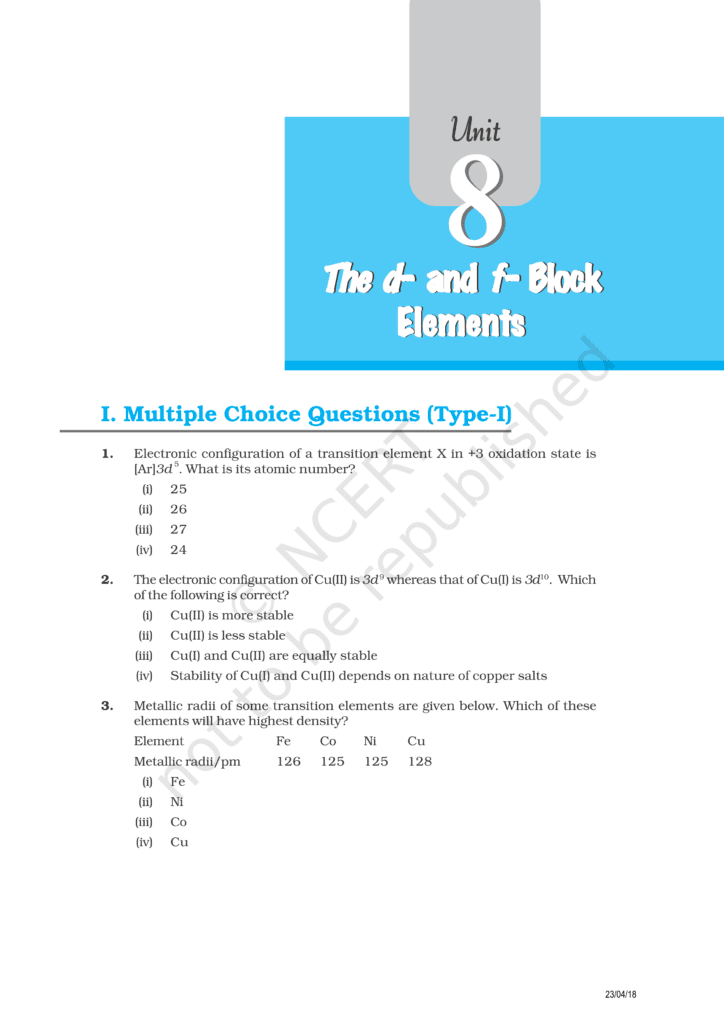Chapter 8 of Class 12 Chemistry, titled “The d- and f-Block Elements,” focuses on the chemistry of transition elements (d-block) and inner transition elements (f-block). These elements are characterized by their partially filled d and f orbitals, leading to unique chemical properties such as variable oxidation states, formation of colored compounds, and the ability to form complex ions.

Class 12th Chemistry Chapter 8 The d- and f-Block Elements Book 📚 download PDF files 👇👇
The chapter begins with a detailed discussion of the d-block elements, covering the transition metals from groups 3 to 12. It explains the general trends in their electronic configurations, atomic and ionic sizes, ionization enthalpies, and oxidation states. The chapter also explores the concept of coordination compounds, highlighting their formation, stability, and importance in various chemical reactions.
Next, the chapter covers the f-block elements, specifically the lanthanoids and actinoids. It delves into their electronic configurations, oxidation states, and the lanthanoid contraction, which affects the properties of subsequent elements. The actinoids, known for their radioactivity, are also discussed, including their applications in nuclear chemistry.
The chapter concludes with the practical applications of d- and f-block elements, emphasizing their role in catalysis, metallurgy, and the production of alloys. The unique properties of these elements make them indispensable in various industrial processes and technological advancements.
In summary, Chapter 8 provides an in-depth understanding of the d- and f-block elements, highlighting their distinct chemical behavior, practical applications, and significance in modern chemistry.
Questions with Answers
1. What are transition elements?
Transition elements are those d-block elements that have partially filled d-orbitals, either in their ground state or in one of their common oxidation states. They include elements from groups 3 to 12 of the periodic table.
2. Why do transition metals exhibit variable oxidation states?
Transition metals exhibit variable oxidation states due to the involvement of both their (n-1)d and ns electrons in bonding, allowing them to lose different numbers of electrons.
3. What is meant by the term ‘lanthanoid contraction’?
Lanthanoid contraction refers to the gradual decrease in the size of lanthanoid ions from La³⁺ to Lu³⁺ due to the poor shielding effect of the 4f orbitals.
4. Explain why Zn, Cd, and Hg are not considered transition metals.
Zn, Cd, and Hg are not considered transition metals because they have a completely filled d-subshell (d¹⁰) in their ground state as well as in their common oxidation states, and thus do not exhibit the typical properties of transition metals.
5. What is a coordination compound?
A coordination compound consists of a central metal atom or ion bonded to a surrounding array of molecules or anions, known as ligands, through coordinate covalent bonds.
6. Why do transition metals form colored compounds?
Transition metals form colored compounds due to d-d electron transitions within the partially filled d-orbitals when they absorb visible light, which leads to specific wavelengths of light being reflected, causing the compounds to appear colored.
7. What is the significance of the f-block elements?
The f-block elements, also known as inner transition elements, include the lanthanoids and actinoids, which are important for their magnetic properties, catalytic activity, and in the case of actinoids, their use in nuclear energy.
8. Describe the actinoid contraction.
Actinoid contraction is similar to lanthanoid contraction, where there is a steady decrease in the ionic radii of actinoids from Th to Lr due to the poor shielding effect of the 5f orbitals.
9. What is the role of transition metals in catalysis?
Transition metals act as catalysts in various chemical reactions due to their ability to adopt multiple oxidation states, form complexes, and provide active sites for the adsorption of reactants.
10. Explain the magnetic properties of transition metals.
Transition metals exhibit magnetic properties due to the presence of unpaired electrons in their d-orbitals. The magnetic behavior can range from paramagnetism to ferromagnetism, depending on the number of unpaired electrons and their interactions.
11. What are the uses of lanthanoids in modern technology?
Lanthanoids are used in various applications such as in the production of strong permanent magnets (e.g., Nd₂Fe₁₄B), phosphors in color television screens, catalysts in petroleum refining, and in the manufacturing of hybrid vehicle batteries.
12. Why is copper considered a good conductor of electricity?
Copper is considered a good conductor of electricity because of its metallic bonding, which allows free movement of electrons, and its relatively low resistivity compared to other metals.
13. What is the significance of the oxidation state +3 in lanthanoids?
The oxidation state +3 is the most stable and common oxidation state in lanthanoids due to the high energy required to remove more than three electrons from the 4f subshell.
14. Explain the formation of complex compounds by transition metals.
Transition metals form complex compounds by donating empty orbitals to accept electron pairs from ligands, leading to the formation of coordinate covalent bonds. These complexes have various geometries depending on the number of ligands and the metal’s electronic configuration.
15. Why do transition metals often exhibit catalytic properties?
Transition metals exhibit catalytic properties because they can easily change their oxidation states, providing a pathway for reactants to be converted into products at a lower activation energy.
16. How does the d-block contribute to the hardness and strength of materials?
The d-block metals, due to their strong metallic bonds and the presence of unpaired d-electrons, contribute to the hardness and strength of materials, making them ideal for constructing tools, machinery, and structural components.
17. What is the role of chromium in stainless steel?
Chromium is added to steel to form stainless steel, where it imparts corrosion resistance by forming a thin layer of chromium oxide on the surface, preventing further oxidation.
18. Describe the preparation of potassium dichromate from chromite ore.
Potassium dichromate is prepared from chromite ore by roasting the ore with sodium carbonate in the presence of air to form sodium chromate, which is then treated with sulfuric acid to produce sodium dichromate. Finally, sodium dichromate is treated with potassium chloride to obtain potassium dichromate.
19. What is the significance of titanium in the aerospace industry?
Titanium is highly valued in the aerospace industry due to its high strength-to-weight ratio, corrosion resistance, and ability to withstand extreme temperatures, making it ideal for aircraft components, engines, and spacecraft.
20. Why are f-block elements also known as inner transition elements?
F-block elements are known as inner transition elements because their last electron enters the inner f-orbitals (4f or 5f), which are shielded by outer d and s orbitals.
21. Explain the difference between lanthanoids and actinoids.
Lanthanoids belong to the 4f series and are generally non-radioactive, while actinoids belong to the 5f series and are mostly radioactive, with applications in nuclear energy and weapons.
22. Why is mercury liquid at room temperature?
Mercury is liquid at room temperature due to its weak metallic bonding, which results from the poor overlap of its 6s orbitals and the relativistic effects that lower the energy of these orbitals.
23. What are alloy steels, and why are they important?
Alloy steels are steels that contain additional elements like chromium, vanadium, or nickel, which enhance properties such as strength, toughness, and resistance to wear and corrosion, making them crucial in construction, manufacturing, and engineering.
24. Describe the role of cobalt in vitamin B₁₂.
Cobalt is a central metal ion in vitamin B₁₂, which is essential for DNA synthesis and red blood cell formation. It helps in the transfer of methyl groups and the proper functioning of the nervous system.
25. What are the applications of uranium in the nuclear industry?
Uranium, particularly the isotope U-235, is used as a fuel in nuclear reactors due to its ability to undergo fission, releasing a large amount of energy used for electricity generation and in nuclear weapons.

Get involved!
Comments